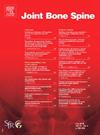Lifetime clinical presentation of Still's disease in the Afro-descendant population of the French West Indies
IF 3.8
3区 医学
Q1 RHEUMATOLOGY
引用次数: 0
Abstract
Introduction
The continuum in Still's disease has never been addressed in Afro-descendant (AD) populations. The aim of this study was to compare the features of Still's disease between children and adults in the AD population of French West Indies (FWI).
Methods
Retrospective longitudinal study from January 2000–2022. We included children and adults with systemic juvenile idiopathic arthritis and Still's disease. Clinical data were obtained from computerized hospital archives, registries of clinicians and the national registry for rare diseases. The main outcome was similarity in cardinal and non-cardinal symptoms.
Results
Fifty-eight patients were included (57% adults). Sex distribution between children and adults was significantly different (Female respectively 36% vs 70.6%, P = 0.03). Diagnostic criteria overlapped in most cases (80%), regardless of age. The children had significantly more typical skin rashes (100% vs 29.4%, P < 0.001), coronary artery dilation (16% vs 0%, P = 0.03), and macrophage activation syndrome (52% vs 9%, P < 0.001). The adults had significantly more inflammatory polyarthalgia without arthritis (91% vs 32% P < 0.001) and pulmonary involvement (51.5% vs 4% P < 0.001). The phenotypes were 86% systemic (43% monophasic, 43% polycyclic) and 14% chronic polyarticular. No difference was found in the number of relapses, use of biologics and mortality.
Conclusions
There is a rationale for considering Still's disease as a single entity in our AD population, focusing on the cardinal symptoms, but particular attention should be paid to the non-cardinal symptoms depending on the age of onset.
法属西印度群岛非洲裔人口中斯蒂尔病的终生临床表现。
简介斯蒂尔病的连续性从未在非洲裔(AD)人群中得到研究。本研究旨在比较法属西印度群岛(FWI)AD人群中儿童和成人的斯蒂尔病特征:方法:2000 年 1 月至 2022 年的回顾性纵向研究。研究对象包括患有系统性幼年特发性关节炎和斯蒂尔病的儿童和成人。临床数据来自计算机化的医院档案、临床医生登记处和国家罕见病登记处。主要结果是主要症状和非主要症状的相似性:结果:共纳入 58 名患者(57% 为成人)。儿童和成人的性别分布有显著差异(女性分别占 36% 和 70.6%,P=0.03)。大多数病例(80%)的诊断标准重叠,与年龄无关。儿童的典型皮疹明显更多(100% 对 29.4%,P=0.03):在我们的 AD 群体中,有理由将 Still's 病视为单一实体,重点关注主要症状,但应根据发病年龄特别关注非主要症状。
本文章由计算机程序翻译,如有差异,请以英文原文为准。
求助全文
约1分钟内获得全文
求助全文
来源期刊

Joint Bone Spine
医学-风湿病学
CiteScore
4.50
自引率
11.90%
发文量
184
审稿时长
25 days
期刊介绍:
Bimonthly e-only international journal, Joint Bone Spine publishes in English original research articles and all the latest advances that deal with disorders affecting the joints, bones, and spine and, more generally, the entire field of rheumatology.
All submitted manuscripts to the journal are subjected to rigorous peer review by international experts: under no circumstances does the journal guarantee publication before the editorial board makes its final decision. (Surgical techniques and work focusing specifically on orthopedic surgery are not within the scope of the journal.)Joint Bone Spine is indexed in the main international databases and is accessible worldwide through the ScienceDirect and ClinicalKey platforms.
 求助内容:
求助内容: 应助结果提醒方式:
应助结果提醒方式:


